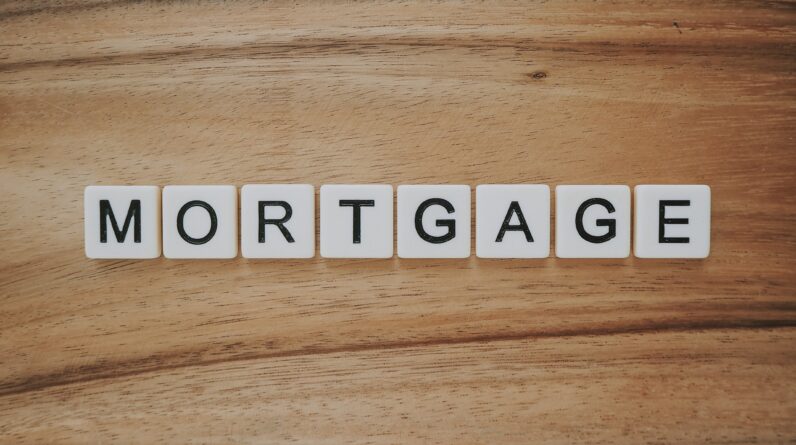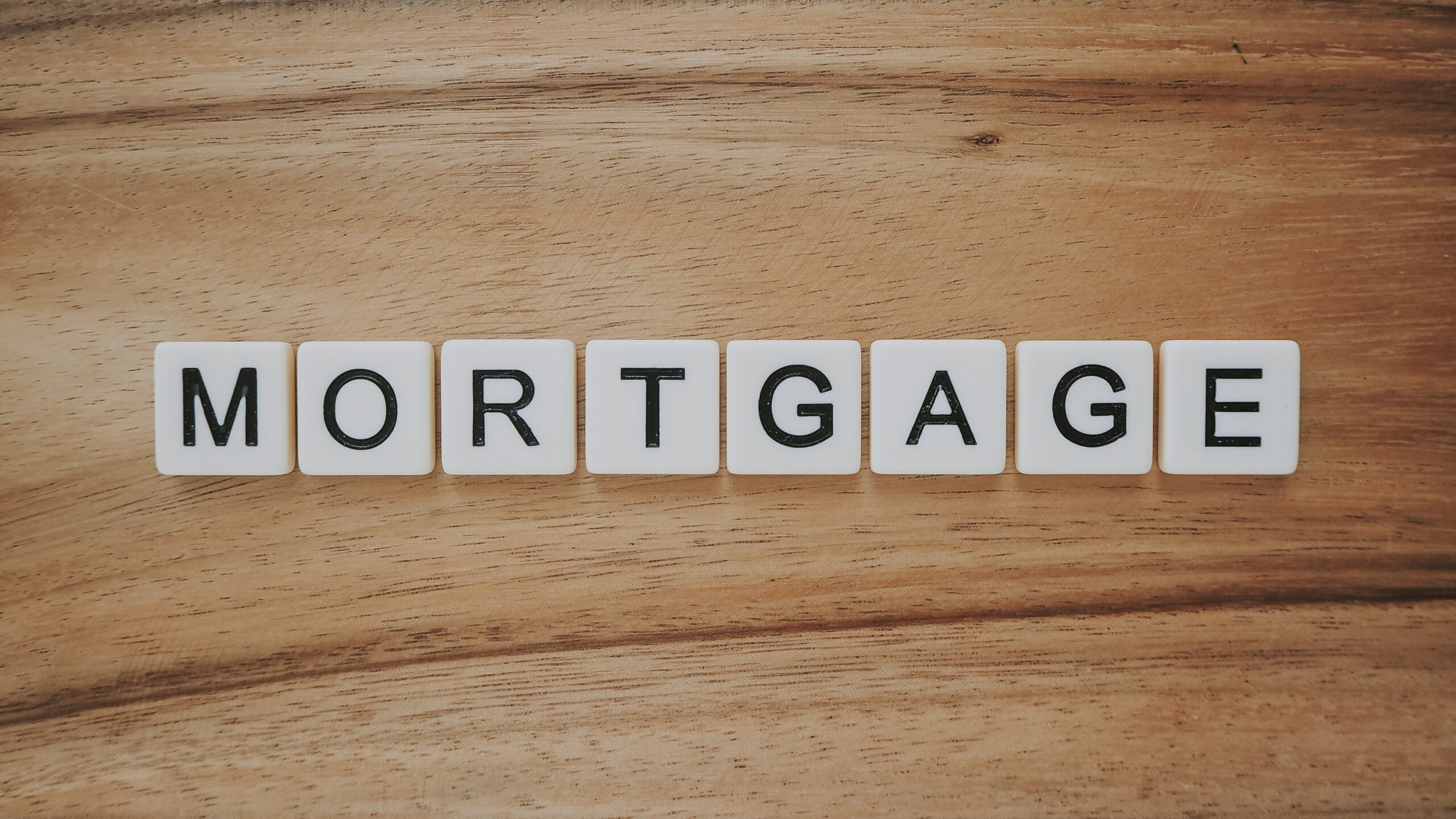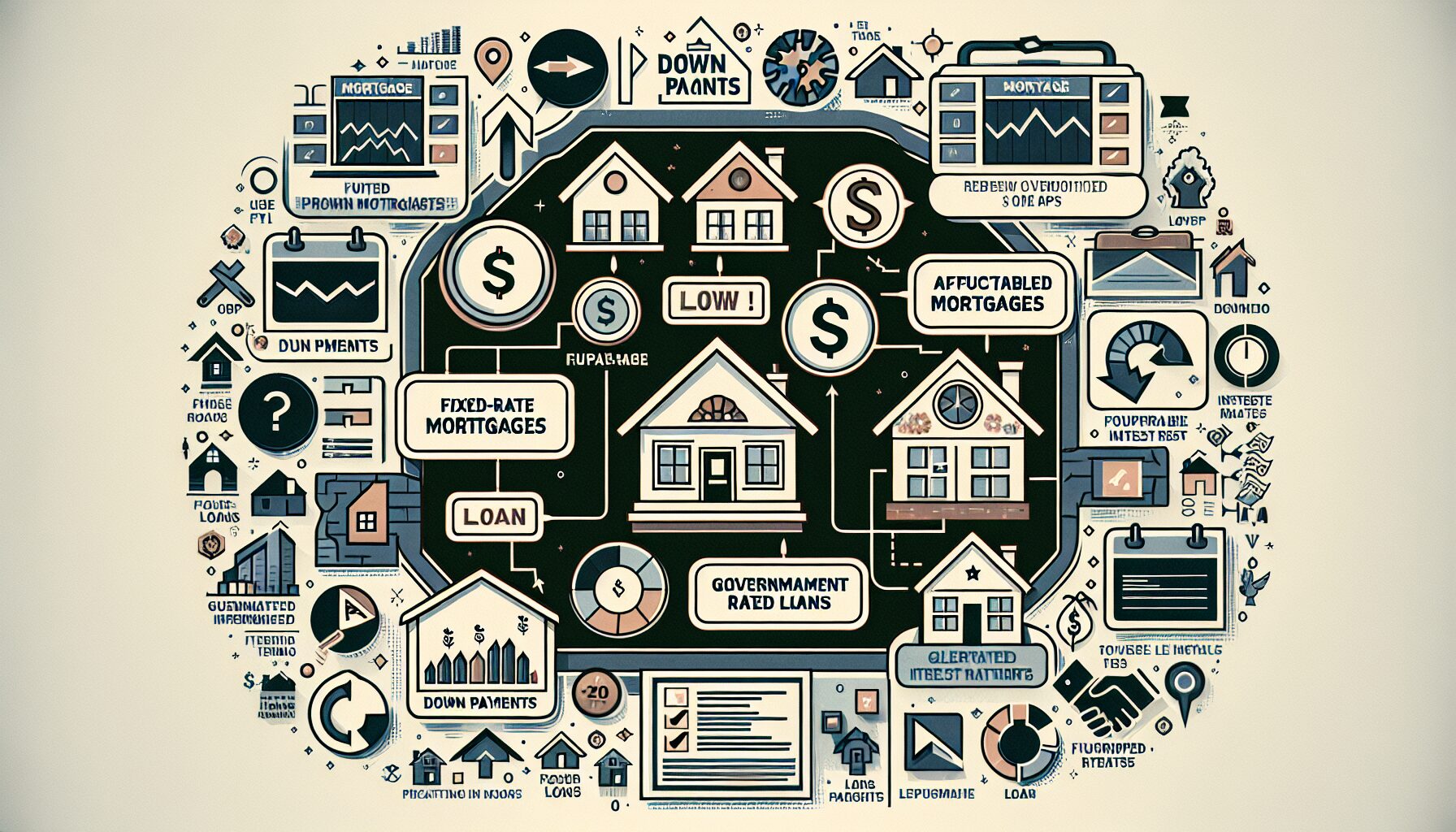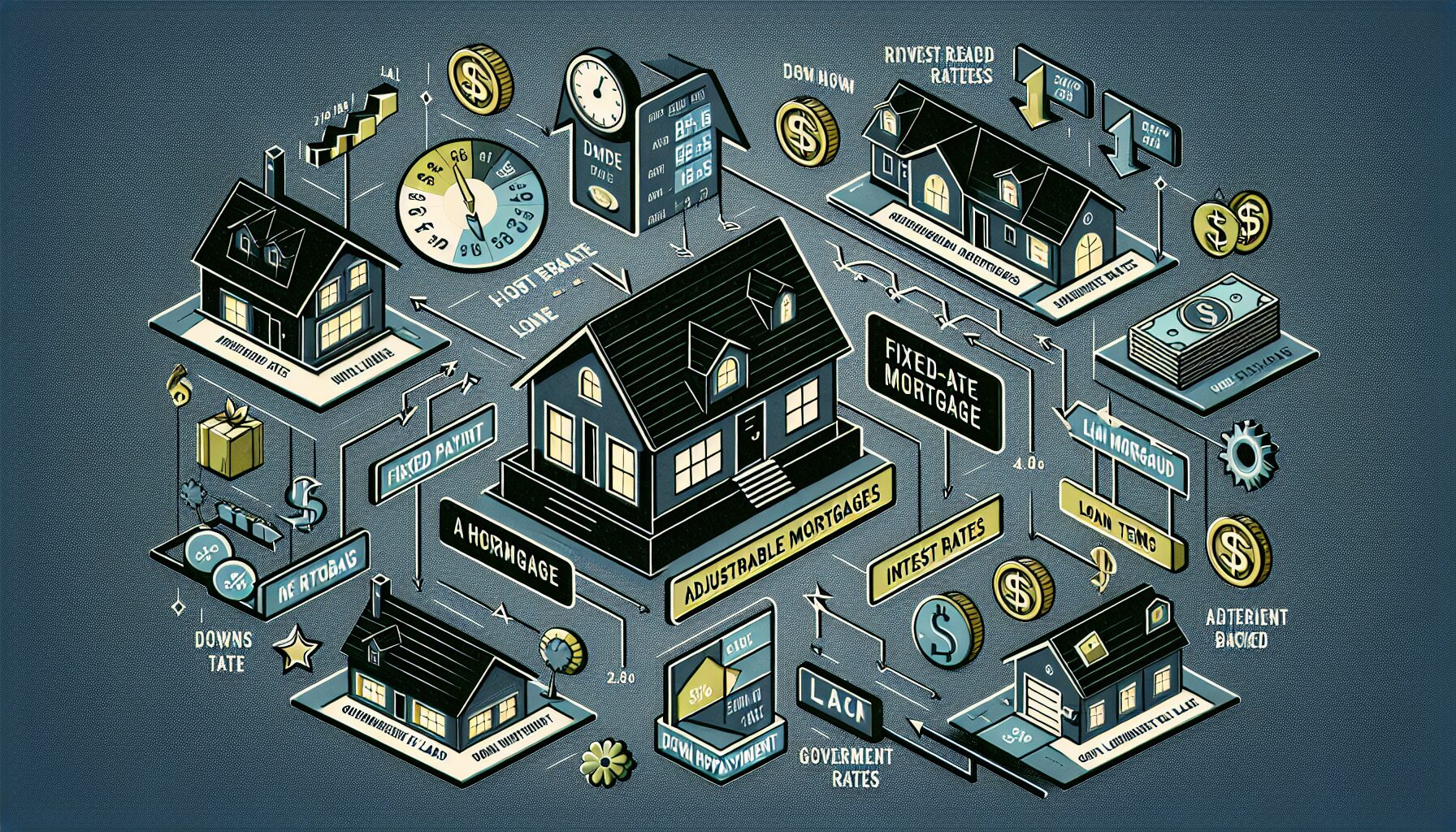
In the world of finance, one type of loan that you might come across is called a mortgage. But what exactly is a mortgage and how does it work? Well, simply put, a mortgage is a loan that is specifically used to purchase a property or real estate. It allows you to borrow a large amount of money from a lender, usually a bank or a financial institution, with the property itself serving as collateral. This means that if you fail to repay the loan, the lender has the right to take possession of the property. So, whether you’re a first-time homebuyer or looking to invest in real estate, understanding the basics of a mortgage is crucial. Let’s explore further to shed some light on this common yet often misunderstood loan option.

Table of Contents
What is a Mortgage Loan?
Definition of a mortgage loan
A mortgage loan is a type of loan that is secured by real estate or property. It is a financial agreement between a borrower and a lender, where the borrower receives a large sum of money upfront and agrees to pay it back over a set period of time with interest. The property being financed serves as collateral, which means that if the borrower fails to repay the loan, the lender has the right to take possession of the property.
Key features of a mortgage loan
There are several key features of a mortgage loan that set it apart from other types of loans.
Firstly, mortgage loans typically have longer loan terms compared to other loans, often ranging from 15 to 30 years. This allows borrowers to spread out their payments over a longer period of time, making homeownership more affordable.
Secondly, mortgage loans often have lower interest rates compared to other types of loans, such as personal loans or credit cards. This is because the loan is secured by the property, which reduces the risk for the lender.
Another key feature of a mortgage loan is the down payment. When obtaining a mortgage, borrowers are typically required to contribute a certain percentage of the purchase price as a down payment. This shows the lender that the borrower is financially invested in the property and reduces the amount of money borrowed.
Finally, mortgage loans often have fixed monthly payments. This means that the borrower pays the same amount each month for the duration of the loan term. This allows for easier financial planning and budgeting, as borrowers know exactly how much they need to pay each month.
Types of Mortgage Loans
Fixed-Rate Mortgage
A fixed-rate mortgage is the most common type of mortgage loan. With a fixed-rate mortgage, the interest rate remains the same throughout the entire loan term. This means that the borrower’s monthly mortgage payment remains constant, providing stability and predictability. Fixed-rate mortgages are suitable for borrowers who prefer a consistent payment amount and want to avoid the risk of interest rate fluctuations.
Adjustable-Rate Mortgage
Unlike a fixed-rate mortgage, an adjustable-rate mortgage (ARM) has an interest rate that may change over time. The initial interest rate on an ARM is typically lower than that of a fixed-rate mortgage, but it can increase or decrease depending on market conditions. Borrowers who choose an ARM often benefit from lower initial monthly payments, but should be prepared for potential payment increases in the future.
FHA Loan
An FHA loan is a type of mortgage loan insured by the Federal Housing Administration (FHA). These loans are designed to make homeownership more attainable for individuals with lower credit scores or limited financial resources. FHA loans offer more flexible qualification requirements and allow for a lower down payment compared to traditional mortgage loans.
VA Loan
A VA loan is a type of mortgage loan available to eligible veterans, active-duty service members, and some surviving spouses. These loans are guaranteed by the Department of Veterans Affairs and offer favorable terms, such as no down payment requirements and competitive interest rates. VA loans are an excellent option for those who have served in the military and want to become homeowners.
USDA Loan
A USDA loan, also known as a Rural Development loan, is a mortgage loan program offered by the United States Department of Agriculture. These loans are designed to help borrowers in eligible rural areas achieve homeownership. USDA loans have low interest rates and no down payment requirements, making them a great choice for individuals or families looking to purchase a home in rural communities.
Jumbo Loan
A jumbo loan is a type of mortgage loan that exceeds the conforming loan limits set by Fannie Mae and Freddie Mac. These loans are commonly used to finance high-value properties or homes in expensive real estate markets. Jumbo loans often have stricter qualification requirements and higher interest rates due to the larger loan amounts.
Process of Obtaining a Mortgage Loan
Pre-qualification and pre-approval
Before applying for a mortgage loan, it is advisable to get pre-qualified and pre-approved. Pre-qualification involves providing basic financial information to a lender, who then assesses your potential eligibility for a loan. Pre-approval, on the other hand, requires a more thorough review of your financial situation and credit history. Getting pre-approved gives you a better idea of how much you can borrow and strengthens your negotiating power when making an offer on a home.
Choosing a mortgage lender
Selecting a mortgage lender is an important step in the mortgage loan process. Take the time to compare lenders and their loan products, including interest rates, fees, and customer reviews. Consider factors such as customer service, reputation, and the lender’s expertise in the type of mortgage loan you are seeking.
Completing the mortgage application
Once you have chosen a lender, you will need to complete a mortgage application. The application will require detailed information about your personal and financial situation, including employment history, income, assets, and debts. Be prepared to provide supporting documents, such as pay stubs, tax returns, and bank statements, to verify the information provided.
Underwriting and loan approval
After submitting your mortgage application, the lender will perform a process called underwriting. During this stage, the lender will verify the information provided, assess your creditworthiness, and evaluate the property being financed. The underwriter will review factors such as your credit score, debt-to-income ratio, and the appraisal value of the property. If everything meets the lender’s criteria, the loan will be approved.
Closing on the mortgage
Once the loan is approved, the final step is the closing process. Closing involves signing various legal documents and paying closing costs, which include fees for services such as the appraisal, title search, and loan origination. The closing agent will guide you through the process and ensure that all necessary paperwork is completed accurately. Once all documents are signed and funds are transferred, ownership of the property is transferred to the borrower, and the mortgage loan becomes active.
Mortgage Loan Terms and Conditions
Loan amount and down payment
The loan amount refers to the total sum of money borrowed from the lender to purchase a property. The down payment is the initial upfront payment made by the borrower towards the purchase price of the property. The down payment is typically expressed as a percentage of the purchase price, and the remaining amount is financed through the mortgage loan. The loan amount and down payment requirements can vary depending on the type of mortgage loan and the borrower’s financial situation.
Interest rates and APR
Interest rates play a significant role in mortgage loans. They determine the cost of borrowing and affect the borrower’s monthly payment amount. Mortgage interest rates can be fixed or adjustable, as explained in the earlier section. The Annual Percentage Rate (APR) reflects the true cost of borrowing by including not just the interest rate, but also any associated fees or costs.
Loan term
The loan term refers to the length of time over which the mortgage loan is repaid. Common loan terms for mortgage loans are 15, 20, or 30 years, although other options may be available. Shorter loan terms typically come with higher monthly payments but can result in significant interest savings over the life of the loan. Longer loan terms offer lower monthly payments but result in higher interest costs over time.
Mortgage insurance
Mortgage insurance is typically required if the borrower makes a down payment of less than 20% of the purchase price. It protects the lender in case the borrower defaults on the loan. Several types of mortgage insurance exist, including Private Mortgage Insurance (PMI) for conventional loans, and Mortgage Insurance Premium (MIP) for FHA loans. The cost of mortgage insurance is added to the borrower’s monthly payment and can be removed once certain conditions are met, such as reaching a certain loan-to-value ratio.
Closing costs
Closing costs are the fees and expenses associated with finalizing the mortgage loan and transferring ownership of the property. These costs can include loan origination fees, appraisal fees, title search fees, attorney fees, and prepaid expenses such as property taxes and homeowners insurance. It is essential for borrowers to budget for these costs as they can range from 2% to 5% of the loan amount.

Credit Score and Mortgage Eligibility
How credit scores impact mortgage eligibility
Credit scores play a crucial role in determining a borrower’s eligibility for a mortgage loan. Lenders use credit scores to assess the borrower’s creditworthiness and likelihood of repaying the loan. A higher credit score indicates a lower risk to the lender, making it easier to qualify for a mortgage loan and potentially secure more favorable terms.
Minimum credit score requirements
The minimum credit score requirements for a mortgage loan can vary depending on the type of loan and the lender’s specific criteria. Generally, a credit score of 620 or higher is considered good and may qualify for most mortgage loans. However, some loan programs, such as FHA loans, have more lenient credit score requirements and may accept scores as low as 500 with a larger down payment.
Improving credit for better mortgage terms
If your credit score is lower than desired, there are steps you can take to improve it before applying for a mortgage loan. These include paying bills on time, reducing debt, and minimizing credit card balances. It is also important to review your credit report regularly for errors or inaccuracies that could negatively impact your credit score. Taking proactive measures to improve your credit can help you qualify for a mortgage loan with more favorable terms and lower interest rates.
Benefits and Risks of Mortgage Loans
Benefits of mortgage loans
One of the most significant benefits of a mortgage loan is the ability to become a homeowner without having to pay the full purchase price upfront. By spreading the cost of the property over time, mortgage loans make homeownership more attainable and affordable for many people. Additionally, mortgage interest payments may be tax-deductible, providing potential tax benefits for homeowners.
Risks involved in mortgage loans
Mortgage loans also come with risks that borrowers should be aware of. The main risk is the potential for foreclosure if the borrower fails to make the required mortgage payments. This can result in the loss of the property and damage to the borrower’s credit score. Interest rate fluctuations can also pose risks, particularly if the loan has an adjustable rate. Rapidly rising interest rates can lead to higher monthly payments and financial strain for borrowers.

The Role of Collateral in Mortgages
Definition and importance of collateral
Collateral refers to an asset or property that is used to secure a loan. In the case of a mortgage loan, the property being financed acts as collateral. By using the property as collateral, the lender has a form of security that they can seize and sell if the borrower defaults on the loan. Collateral is essential as it reduces the risk for the lender, which, in turn, allows them to offer more favorable terms, such as lower interest rates or higher loan amounts.
Types of collateral used in mortgages
The collateral in a mortgage loan is the property itself. Whether it is a home, condominium, or other type of real estate, the property is used to secure the loan. The value of the property is an important consideration as it determines the loan-to-value (LTV) ratio. The LTV ratio is the percentage of the property’s value that is financed through the mortgage loan. The higher the LTV ratio, the greater the risk for the lender, which can result in higher interest rates or mortgage insurance requirements.
Repayment Options for Mortgage Loans
Principal and interest payments
When repaying a mortgage loan, borrowers typically make monthly payments that include both principal and interest. The principal portion of the payment goes towards reducing the loan balance, while the interest portion compensates the lender for lending the money. As the loan is gradually paid off, the proportion of the payment towards principal versus interest changes. Early in the loan term, more of the payment goes towards interest, while towards the end, more goes towards the principal.
Amortization and loan schedule
Amortization refers to the process of gradually paying off the mortgage loan over time through regular payments. The loan schedule outlines the specific dates and amounts of the borrower’s monthly payments throughout the loan term. The schedule shows how the loan balance decreases with each payment, and the borrower builds equity in the property.
Bi-weekly mortgage payments
Some borrowers choose to make bi-weekly mortgage payments instead of monthly payments. This payment option involves making half the monthly payment every two weeks, resulting in 26 payments per year. Bi-weekly payments can help accelerate the loan payoff timeline and save on interest costs compared to monthly payments. However, it is essential to check with the lender beforehand to ensure that they offer this payment option and understand any associated fees.
Additional payment options
Many mortgage loans offer the flexibility to make additional payments towards the principal balance. These extra payments can help reduce the loan term and save on interest costs. Borrowers can choose to make larger payments periodically or set up automatic additional payments. Before making extra payments, it is important to check with the lender to ensure that there are no prepayment penalties or restrictions.

Mortgage Refinancing
Definition and purpose of mortgage refinancing
Mortgage refinancing is the process of replacing an existing mortgage loan with a new loan, often with more favorable terms. The main purpose of refinancing is to reduce monthly mortgage payments, secure a lower interest rate, or change the loan term. Refinancing can also be used to tap into the equity built in a property to obtain cash for home improvements, debt consolidation, or other financial needs.
When to consider refinancing
There are several situations in which it may be beneficial to consider refinancing a mortgage. One common scenario is when interest rates have dropped since the original loan was taken out. By refinancing to a lower interest rate, borrowers can potentially save thousands of dollars over the life of the loan. Refinancing may also be suitable for borrowers who want to switch from an adjustable-rate mortgage to a fixed-rate mortgage, or for those who have improved their credit score and want to qualify for better loan terms.
Process of refinancing a mortgage
The process of refinancing a mortgage is similar to obtaining a new mortgage loan. It typically involves completing a new loan application, providing financial documentation, and undergoing a credit check. The lender will assess the borrower’s eligibility and evaluate the property. If approved, the existing loan will be paid off, and a new loan with the agreed-upon terms will be established. It is important to carefully review the costs associated with refinancing, such as closing costs and any prepayment penalties, to ensure that the benefits outweigh the expenses.
Conclusion
In conclusion, a mortgage loan is a valuable tool for individuals and families looking to achieve the dream of homeownership. With a wide variety of mortgage loan options available, borrowers can select a loan type that aligns with their financial goals and circumstances. Understanding the process of obtaining a mortgage loan, the terms and conditions involved, and how credit scores impact eligibility can help borrowers make informed decisions and secure the best possible loan terms. While mortgage loans come with risks, the benefits of homeownership and the opportunity to build equity make them a worthwhile investment. Whether you are a first-time homebuyer or looking to refinance an existing mortgage, it is important to carefully consider your options, seek guidance from professionals, and choose a loan that fits your needs and financial situation.








